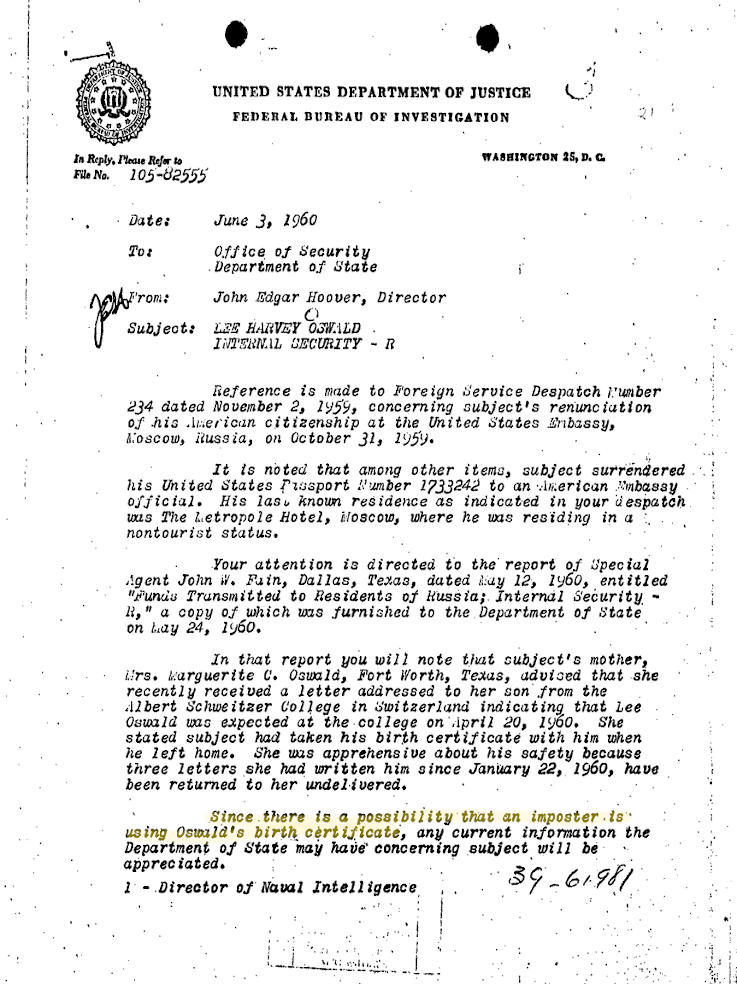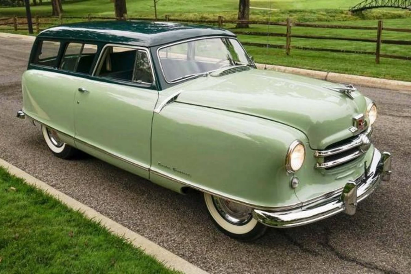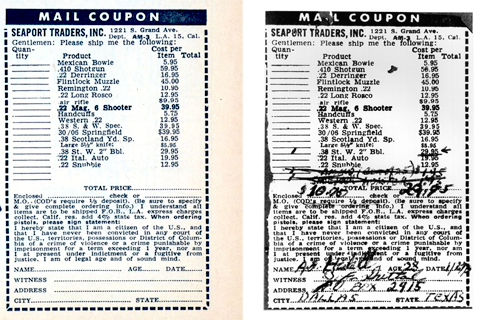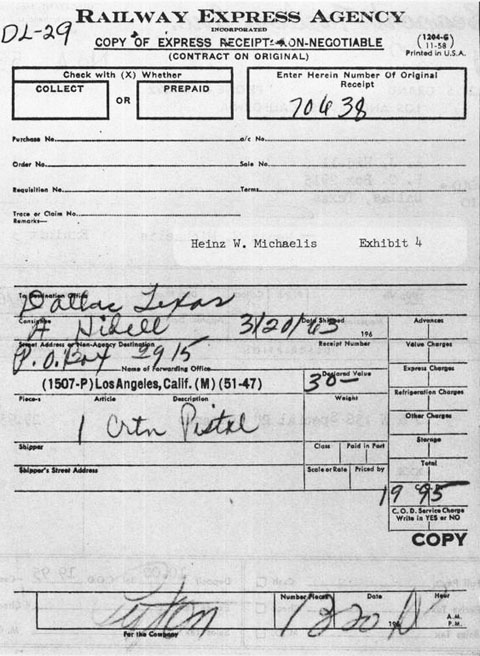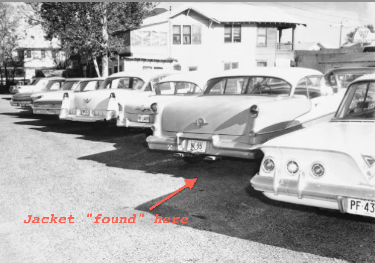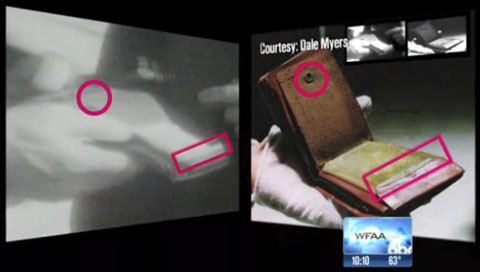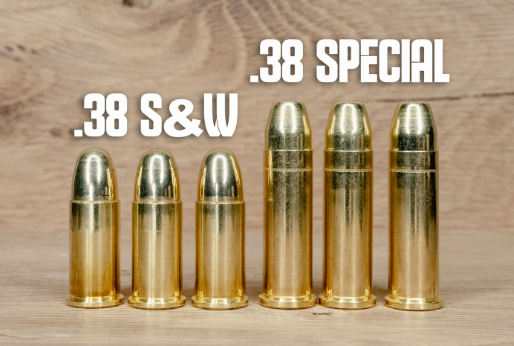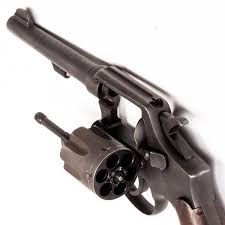Part 2: Oswald Double and How the Weapon was Purchased
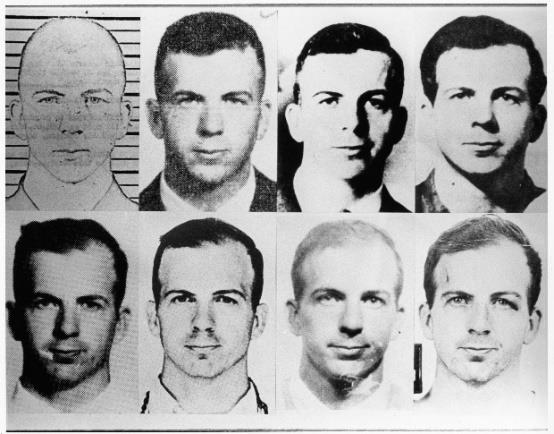
Here is just a sampling of those inexplicable sightings of a “second” Oswald:
- June 3, 1960 — F.B.I. Director J. Edgar Hoover wrote a memo stating that someone in the United States may be using defector Lee Oswald’s birth certificate and impersonating the ex-Marine while he is in the Soviet Union.
- January 20, 1961 — Two men visited the Bolton Ford dealership in New Orleans and indicated their intent to purchase 10 Ford Econoline trucks for the Friends of Democratic Cuba. One of the men who identified himself as JOSEPH MOORE wrote out a bid form. Moore’s friend, who identified himself as LEE OSWALD, told the assistant manager that he would be responsible for payment.
- November 1963 — “Oswald” walked into the Downtown Lincoln Mercury dealership to inquire about purchasing an automobile. A salesman accompanied Oswald for a test drive, during which Oswald drove at high speeds on the Stemmons Freeway, making the salesman very uneasy. Afterwards he told the salesman he wasn’t ready to buy, but would be coming into a considerable amount of money shortly. The salesman wrote down the man’s name, LEE OSWALD, for future reference.
- November 16, 1963 — “Oswald” is seen at the Sportdrome Gun Range in Oak Cliff. He is boasting about his Italian-made carbine with its power scope to other patrons and firing at their targets, causing a scene.
- November 20, 1963 — The real Lee Oswald was known to be a regular “coffee customer” at the Dobbs House Restaurant just a short walk from his rooming house. Lee would read a book while drinking his coffee. However, at 10 a.m. on the Wednesday before the assassination, and while the real Lee was working at the book depository, a man came in and ordered eggs. He soon began cursing at the waitress, and complaining loudly that his eggs were runny. Officer J.D. Tippit was said to have been in the restaurant at this time. The owner and several employees identified the unruly individual as Lee Harvey Oswald.
- November 22. 1963 —On the morning of the assassination, while Oswald had already reported for work at the book depository, a young man purchased two bottles of beer at the Jiffy Store on Industrial Boulevard. The store is located just a short walk from Dealey Plaza. When asked to present ID, the customer showed store clerk Fred Moore a Texas driver’s license for a Lee Oswald, birthdate October 1939. An hour later, the same individual returned to buy some peco brittle, which is a special peanut and coconut type brittle. Moore remembered the purchases because he thought the combination made for one very unusual breakfast.
- November 22. 1963 — Just a few minutes after the assassination, Lee Oswald departed the TSBD, walked several blocks east, and boarded a city bus. A transfer issued by the driver of that bus would later be found on Oswald’s person. However, at about the same time Oswald was boarding the bus on Elm Street, more than one witness— including a deputy sheriff — saw another “Oswald” run down the Grassy Knoll next to the TSBD and jump into a light green Nash Rambler station wagon driven by a Latino man, possibly Cuban. The vehicle then headed west under the triple underpass.
Who Purchased Oswald’s .38 Revolver?
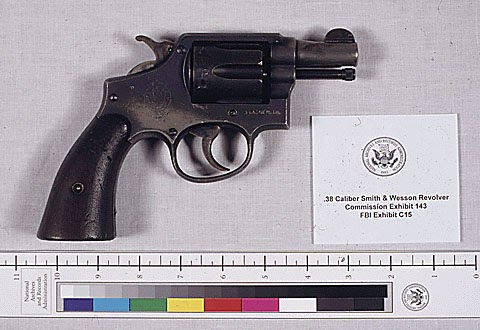
First, if Lee Oswald had wanted to purchase a weapon for nefarious purposes, he could have simply walked into any sporting goods store or hardware store in Texas, paid cash, and walked out with an untraceable gun. In 1963 guns could even be purchased at flea markets and yard sales — no license was necessary to sell guns. The only time purchasing a gun in Texas required paperwork and left a trail of evidence was in the case of the sale of weapons though the mail. Naturally, safeguards had been put into place to prevent juveniles from ordering deadly weapons through magazines and comic books.
Oswald allegedly ordered a .38 pistol through an advertisement placed in an April, 1963 men’s adventure magazine by Seaport Traders of Los Angeles. Oswald supposedly sent an order form and $10.00 in cash or money order to Seaport, requesting that a pistol be shipped via Railway Express Agency to Lee’s post office box registered to his name in Dallas, Box 2915. Inexplicably, the coupon order form was dated 1/27 even though the order form was not published in True Adventures until March.
The U.S. Post Office would not handle private cargo for a private shipping company such as REA. The gun could not be shipped directly to a P.O. Box. Instead, the gun would be sent via Railway Express Agency--an early version of FedEx (Federal Express--to REA’s facility in downtown Dallas. The Dallas REA office would then send a notice by postcard to the buyer’s post office box that the package could be picked up at the REA facility.
For this to happen, however, certain rules and regulations needed to be followed first:
- The REA postcard had to be sent by REA to the buyer’s P.O. Box.
- The buyer had to bring the postcard to REA’s office in Dallas.
- The buyer had to present a certificate of good character to REA signed by a justice of the peace, county judge, or district judge from the buyer’s county of residence.
- The buyer had to provide to REA proof of ID submitted on Form 5024 required for all pistols and small firearms.
- The buyer had to pay the balance owed to REA.
However, is there any evidence that these rules were followed in the case of the Smith & Wesson .38 allegedly purchased by Lee Oswald? No. All that the Warren Commission provided was a copy of a receipt, not even the original. And that receipt was signed by neither Oswald nor A.J. Hidell, Oswald’s supposed alias.
- There is no evidence REA ever sent a postcard to Oswald’s P.O. Box.
- There is no evidence that Oswald or anyone else brought the postcard into REA.
- There is no evidence of a certificate of good character.
- There is no 5024 form with proof of ID.
- There is no witness saying Oswald or anyone else picked up the pistol, or when.
- There is no evidence of payment of the balance owed, $19.95.
- There is no evidence of remittance of payment from REA to Seaport Traders.
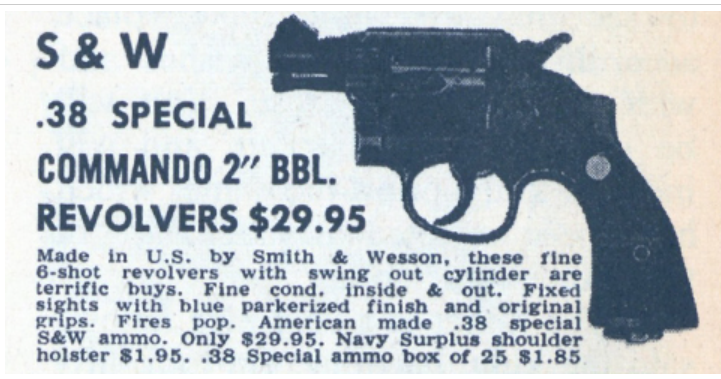
We are supposed to believe that Oswald rented a P.O. box under his own name, sent in a coupon to Seaport Traders under the alias A.J. Hidell, had no ID or certificate of good character, and then signed the receipt using the name of Paxton or Patton ( see below). Then walked away with the gun with nobody witnessing this unlikeliest of transactions?
It would seem rather that someone else ordered this weapon and created a paper chase to make it appear the “patsy” Lee Oswald ordered a mail order pistol through Seaport Traders.
The evidence does not support that Lee Harvey Oswald ever purchased this gun from Seaport Traders, an accusation he denied before his untimely death at the hands of Jack Ruby in the basement parking garage of Dallas Police headquarters. The pistol apparently did wind up in his possession at the theater, but that is no proof he ordered the weapon. The origin of the S&W .38 Victory model pistol, serial number V510210, remains an unsolved mystery.
Who Stashed a Jacket Behind the Texaco?
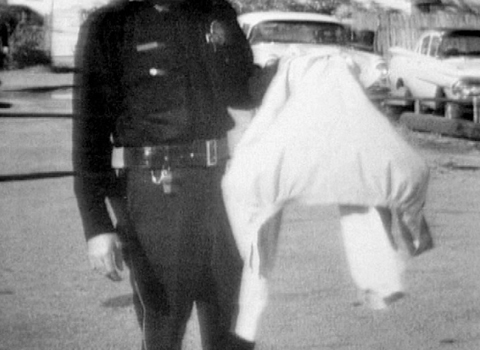
In fact, the Eisenhower jacket is the weakest link in the government’s shaky chain of evidence against Oswald in the slaying of Officer Tippit.
Warren Commission exhibit 162 was allegedly found partially hidden underneath a 1954 Oldsmobile in parking space 17 behind Ballew’s Texaco and service station at the corner of Jefferson Boulevard and Crawford Street. It was allegedly stashed there as the killer made good on his escape by foot. No one saw the killer put it there, however, and no one knows who found the jacket. Officially, DPD Captain William “Pinky” Westbrook was supposed to have found the jacket, but that’s not the story Westbrook told the Warren Commission in 1964. “Some officer, I feel sure it was an officer, I still can’t be positive, pointed this jacket out to me,” stated Captain Westbrook for the record. Dallas police radio logs indicate that an Officer 279 first mentions the jacket at about 1:25 p.m. — however Capt. Westbrook did not arrive on scene until 1:40 p.m. The identity of “Officer 279” remains a mystery, as does the origin of the jacket.
The jacket was described as a light grey man’s jacket, size M (medium). Oswald weighed 130 pounds at the time of his death, and all his other clothes were men’s size small.
Laundry marks and cleaning tags present in the jacket indicated the garment had been professionally cleaned on multiple occasions. Marina Oswald, however, claimed that she had always hand washed Lee’s jackets and other clothes. Despite their best efforts, investigators could not trace the laundry tags to any specific cleaning establishment. No evidence of professional cleaning was found on any of Lee Oswald’s other garments.
Witnesses who saw the gunman fleeing from 10th & Patton generally disagreed the found jacket was the same as that worn by the killer. Some seven witnesses either failed to identify the jacket, or straight out said the found jacket did not match the jacket worn by Officer Tippit’s killer. Because the Tippit witness descriptions of the jacket worn by the killer were so wide-ranging, the Warren Commision was forced to officially state that “the eyewitnesses vary in their identification of the jacket.” This hardly supports a convincing identification of the garment allegedly discovered behind the Texaco station.
Authorities tried to connect the jacket to Oswald by saying some fibers found on the mystery jacket were “consistent” with the brown shirt Lee Oswald had been wearing when arrested at the Texas Theater. What those same authorities fail to mention, however, is that one of the few details the Tippit witnesses agree upon is that the gunman had been wearing a white shirt, not a brown one.
Interestingly, the Warren Commission insisted on describing the found jacket as being light-grey, although descriptions from November 22, 1963 refer to the garment as being white. However, modern color photographs of the evidence reveal the jacket to be tan or beige.
Effectively, the Eisenhower jacket found almost two blocks from 10th & Patton was a prosecutorial dead end. It was likely not related to the homicide. If it was, in fact, the killer’s jacket, the shooter almost certainly was not Lee Oswald. And if the jacket was Oswald’s, the possibility it was a throwdown or plant would have to be seriously considered — especially in light of a piece of astounding evidence that was revealed in 1996.
Retired FBI agent James Hosty, the man once tasked with keeping tabs on Soviet “defector” Lee Oswald while he was in Dallas, published a book titled Assignment: Oswald. In Hosty’s retelling of events, he would release a tidbit of information that would impact the Tippit case like a bombshell. Hosty described how fellow FBI agent Bob Barrett had been present at 10th & Patton for the initial investigation of J.D. Tippit’s murder. While the scene was still being processed, Captain William Westbrook of the DPD showed Special Agent Barrett a man’s billfold and asked if he’d ever heard of a character named Alek Hidell. Agent Barrett had gone to 10th & Patton at the request of Dallas County Sheriff Bill Decker.
Barrett told Westbrook no, he never heard of this Hidell person. And Lee Oswald? No, Barrett couldn’t remember anybody by that name either.
Mention of this incident in Hosty’s book set off a firestorm in the JFK critical community. It had been well known that Dallas Police Detective Paul Bentley had removed a billfold from Oswald’s back pocket after the suspect’s arrest at the Texas Theater. While in custody and en route to police headquarters in the back seat of Westbrook’s unmarked police car, Oswald had famously refused to give detectives his name. Bentley, noticing that Oswald had a billfold bulging from his back pants’ pocket, reached over and removed it. Discovering ID for two separate individuals inside the billfold, Bentley asked the suspect if he was Alex Hidell or Lee Oswald.
“You’re the detective,” Oswald had reportedly replied defiantly: “You figure it out.”
Detective Gerald Hill later testified to the Warren Commission regarding this incident. Officially, Oswald’s wallet had been taken from his person after his arrest. So how could his wallet possibly have been found at the Tippit murder scene?
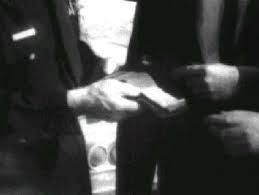
'Why would they be asking me questions about Oswald and Hidell if it wasn't in that wallet?' an angry Bob Barrett observed. “They said they took the wallet out of his pocket in the car? That's so much hogwash,” Barrett fumed. “That wallet was in [Captain] Westbrook's hand.”
A check of raw news footage from that day proved retired Agent Barrett’s version of events to have been accurate and truthful. There, in black & white, Westbrook could clearly be seen handling a man’s wallet and showing it to other law enforcement personnel. Could the wallet have been Officer Tippit’s wallet? Absolutely not. Tippit’s wallet was black, the wrong color, and was still on his person when the deceased’s body was transported to Methodist Hospital.
Lieutenant Kenneth Croy, the reserve Dallas cop who had appeared so quickly on scene after Tippit’s slaying, was also still alive in 1996 when the wallet controversy first erupted. Asked about the alleged Oswald wallet, Croy explained that yes, someone in the growing crowd had handed him a wallet, which he later turned over to Captain Westbrook. Croy failed, however, to get the name of the individual who had supposedly discovered and handed him the wallet. Croy, in fact, had failed to record anything that day, for despite being the first policeman to have arrived on scene at the murder of a fellow officer, Croy neglected to even file a report.
When testifying before the Warren Commission, Lt. Croy said he knew and recognized several of the officers who were present at the scene that afternoon — but he couldn’t remember the name of any of them, not one. The mystery wallet was never listed in Captain Westbrook’s report. After being shown to Agent Barrett and others at the Tippit scene, the billfold simply disappeared. Once Oswald’s wallet had been taken from his person upon arrest, the second Oswald wallet had to disappear. Two Oswald wallets that day were simply one too many.
Before his death, Dallas Police Sergeant Leonard Jez was asked to comment on the presence of Oswald’s wallet at 10th & Patton. Jez had been one of several officers officially present at 10th & Patton, and whom Lt. Croy could not recall. Jez verified the existence of the wallet at the murder scene, he had seen it with his own eyes
“Don’t let anybody bamboozle you,” stated Jez flatly. “That was Oswald’s wallet.”
Photographic comparisons between the wallet in the news footage and Oswald’s wallet stored in the National Archives proves they are similar in style but in fact undoubtedly two separate wallets.
So, if the second Oswald wallet that mysteriously appeared and then disappeared on E. 10th street was very likely a plant or thrown down, and if the dubious grey/white/tan Oswald jacket found by a person or persons unknown behind Ballew’s Texaco was possibly a throw down…is it possible any other evidence left at the Tippit murder scene was not what it appeared to be? To find out, dear reader, keep on reading…
Why Did the Killer Leave Four Empty Shells Behind?
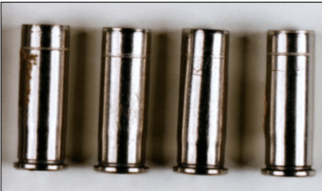
Oswald had that pistol on his person in the darkness of the Texas Theater less than a mile from the Tippit murder. Had Lee Oswald lived to stand trial, how could any defense attorney possibly have explained that fact away? TO THE EXCLUSION OF ALL OTHER WEAPONS.
Apologists for the Warren Commission Report who continue to believe that Lee Oswald committed these murders will often bend regarding the other points of evidence against the accused:
- Yes, eyewitness testimony is often unreliable, especially if suspect Oswald had a so-called double.
- Undoubtedly the paperwork linking Oswald to the .38 Smith & Wesson was flimsy and incomplete at best.
- For sure the finding, chain of custody, and identification regarding the alleged Oswald jacket was dubious.
But the shells, found at 10th & Patton, matching the pistol in Oswald’s possession to the exclusion of all other pistols? That sounds like slam dunk, case closed, throw the book at Oswald type of evidence.
Maybe, but not so fast…
Now, believers in Oswald’s innocence have offered several various scenarios to explain away the ballistics match to Oswald’s Smith & Wesson .38:
- Tippit was killed by at least one, and possibly two killers armed with automatic pistol, not revolvers. This was why initial police reports described the suspect as being armed with an automatic, not a revolver.
- The Dallas Police Department later switched the shells before handing them over to the FBI for closer inspection.
- Captain Westbrook, once back at his desk at police headquarters, later switched the killer’s pistol for Oswald’s pistol.
I don’t believe any of these things happened. Oswald was already framed for the Tippit murder by the time the killer disappeared somewhere behind Ballew’s Texaco. The wallet, the shells, the jacket…they all spelled game, set, and match for the blaming of the patsy.
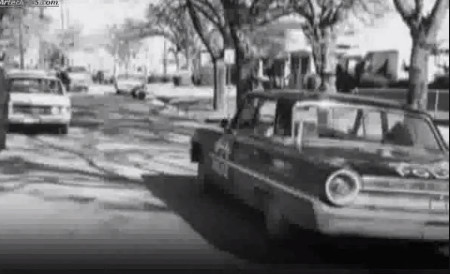
The secret to the frameup lies in the special type of revolver given to patsy Oswald — and used by the professional assassin who ended Officer Tippit’s life, as Helen Markham so aptly described, “in the wink of your eye.” Oh, these guns were nothing outwardly special…World War II surplus models purchased for $29.95 apiece. But they featured one unusual characteristic that made the frameup work. These revolvers, actually the entire lot of some 500 of them, were modified and rechambered for sale back in the United States. It was the use of rechambered .38 revolvers that made the simple but effective Oak Cliff deception possible.
The Smith & Wesson .38 “Victory” model was manufactured in the U.S. for homeland defense use during World War II. The handgun found on suspect Oswald was part of a shipment originally sent to Great Britain. Luckily, though the Nazis did considerable damage by dropping bombs and missiles on our island nation ally, they were never able to mount a troop invasion across the English Channel. So, the .38 Victory models remained in storage in Britain for the duration of the war. Many years later, an enterprising sporting goods company repurchased the war surplus weapons and reimported them back home to America.
Post WWII a newer type of ammunition was becoming popular and in increasing demand for use with .38 revolvers. Known as the .38 special round, the new ammo had more proven stopping power than the traditional .38 S&W bullets. By comparison, the .38 specials were much longer than the .38 regular ammo (which became known as .38 shorts)…but the .38 special cartridges were also slightly thinner or smaller in diameter than the .38 S&W “short” ammo.
As the .38 special ammo became more widely used by police and military units, civilian gun owners also started to favor the newer ammo that packed a bigger punch.
Therefore, to make these reimported old revolvers more marketable to the public, the seller had a gunsmith (L.M. Johnson of Van Nuys, CA) make certain modifications to the weapons. First, the barrels of these handguns were cut down from 5 inches to 2¼ inches, making them “snub nose” revolvers for easier concealment. Second, the revolvers were “rechambered” by having the old cylinders swapped out for new cylinders designed to accept the more popular .38 special ammo with more stopping power — but also with slightly different dimensions.
However, since the .38 special bullets are only slightly narrower than the standard .38 S&W cartridges, the guns were never re-barreled. This left the barrels for these handguns slightly oversized for the new ammo being used. Again, close enough for government work!
These modified guns functioned just fine and were well suited and modestly priced for someone looking for a handy, dependable self-defense weapon. But the slightly oversized and shortened barrel left the revolvers with one highly unusual characteristic — as the slugs were fired and traveled through the barrel, they each took an “erratic” passage. Basically, the slugs would wobble slightly and would not contact the barrel the same way each time the weapon was discharged. The result? The oversized barrel would impress upon the lead bullets inconsistent individual microscopic characteristics. This made identification of a specific revolver that fired a specific bullet impossible once the weapon had been rechambered in this way.
In the words of the HSCA firearms panel tasked with examining the Oswald revolver against the four lead slugs taken from Officer Tippit’s body, the panel found that, “Due to the inconsistent markings on the recovered bullets and on all the test-fired bullets, the panel concluded that the CE 602 through CE 605 bullets (the slugs recovered from Tippit’s body) could not be conclusively identified or eliminated as having been fired from the CE 143 revolver (the handgun allegedly in Oswald’s possession at the Texas Theater).”
Had Lee Oswald been carrying a revolver that had not been modified and rechambered, then the four bullets taken from J.D. Tippit’s body would likely have been either positively matched or positively eliminated as having been fired from the gun allegedly in Oswald’s possession.
But wait…didn’t the killer so conveniently leave four shells at the scene of the murder? Why yes, he did! But wait again, only automatic pistols eject the empty shells as the weapon is fired. Shells from a revolver such as the S&W .38 special must be manually unloaded — which is exactly what witnesses at the scene said the killer did.
When Detective Gerald Hill arrived at 10th & Patton and heard that several shells had been recovered by witnesses, he logically assumed the killer had been armed with an automatic which had ejected the shells. Had Hill personally inspected the shells, he would have seen they were labeled .38 SPL and had come instead from a revolver. But who murders a cop and then stops mid-flight to dispense highly incriminating shells? It made absolutely no sense.
“Now there’s a dumb crook,” quipped Texas JFK researcher Jim Marrs.
Was the killer just plain crazy…or crazy like a fox?
At approximately 1:40 p.m. Hill radioed the following message…“The shell found out the scene (of the shooting) indicates that the suspect is armed with — an automatic .38 rather than a pistol.”
This incorrect broadcast has fueled speculation for years that Tippit was slain with an automatic pistol or pistols. But the slugs recovered from his body — and the shells dropped at the scene — indicate otherwise. Something else was afoot.
Patrolman J.M. Poe caused a bit of a stir with his testimony before the Warren Commission when he stated he could not find the ID marks he had allegedly placed on two of the shells (hulls) recovered at 10th & Patton by witness Domingo Benavides. This led some critics to surmise that the shells had been switched. But under direct examination, Poe hesitated to definitively confirm that he had marked those two shells. “I couldn’t swear to it, no sir.” Later, in an interview granted to JFK researcher Joseph McBride, Detective Jim Leavelle, who headed up the Tippit investigation, scoffed at the idea Poe had ever marked the shells. “Actually, they never marked ‘em. There wasn’t no point in it. We don’t mark’em.”
Leavelle, who was the homicide detective wearing the Stetson and handcuffed to Oswald when he was shot by Ruby, admitted the ballistics on the Tippit case were frankly “a mess.”
Rep. Hale Boggs from Louisiana, the youngest member of the Warren Commission, became so frustrated with the ballistics in the Tippit case that he asked directly, “What proof do you have that these are the bullets?” Apparently, Boggs never received a satisfactory answer.
Yes, Tippit’s killer and the conspirators behind him had been clever, but perhaps a tad too clever for their own good. You see, the cartridge cases — two Western-Winchester and two Remington–Peters — did not match up with the fatal bullets— which were three Western-Winchester and only one Remington-Peters. “The last time I looked,” noted Jim Garrison wryly, “the Remington–Peters Manufacturing Company was not in the habit of slipping Winchester bullets into its cartridges, nor was the Winchester–Western Manufacturing Company putting Remington bullets into its cartridges.”
It is important to note that the HSCA firearms panel found the components (recovered shells and slugs) of these cartridges were all consistent withfactory loaded ammunition. There should have been no discrepancy (2-2 vs. 3-1) between the shells and the fatal lead slugs. This was not home-loaded ammo. Something was clearly wrong.
The panel tried to explain this show-stopping mismatch by offering the following two solutions:
- One Western-Winchester cartridge case was not recovered or is missing, and one Remington-Peters lead bullet missed Officer Tippit and also was not recovered.
- One Western cartridge case was not recovered or is missing, and one fired Remington-Peters cartridge case was in the revolver prior to the Tippit shooting.
Since the escape route of the gunman was witnessed by several people, it seems hard to believe that a shell would have gone unrecovered along such a narrow pathway. And as far as a possible fifth shot was concerned, that idea was largely unsupported by the earwitness testimony.
The witnesses within direct earshot of the murder, along E. 10th Street, all heard between two and four shots. That the shots were fired in such quick succession probably meant that some witnesses perceived multiple adjacent loud reports as a single gunshot.
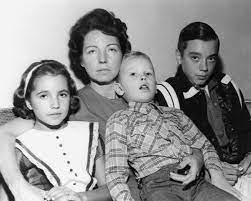
Even the HSCA firearms panel agreed these two theories were speculation, not supported by the available evidence. The available evidence indicates four shots. If only four shots were fired, and the slugs and shells do not match, then Lee Oswald’s handgun did not kill Officer Tippit. Someone else with some other gun did.
But the shells…they were proven to have been fired from “Oswald’s” gun to the exclusion of all other weapons!
Yes, they were. But the shells weren’t fired at 10th & Patton, or from the handgun that killed Officer Tippit. They were fired sometime before November 22 — before the revolver was in all probability given to Oswald by those involved in the plot. Recall, there is no proof Oswald ever picked up that weapon. Which happens to correspond to the DPD issue.
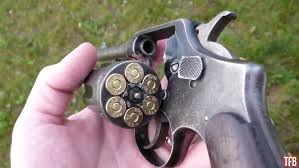
There’s a time-tested adage concerning the successful completion of difficult tasks…KISS. Keep it simple, stupid. Had the conspirators stayed with all Western or all Remington-Peters cartridges, this colossal mistake would never have been made. Oswald had no ammo amongst his possessions, and no gun-cleaning paraphernalia. The idea of framing him with mixed ammo was really an overreach.
The conspirators purchased at least two Smith & Wesson 38 Special Commando snub-nose revolvers from Seaport Traders and created a paper chase leading to the Oswald-Hidell P.O. Box for one of them. Same manufacturer, same lot, same modifications, same gunsmith. Wallet, shells, jacket…game, set, and match.
Only rechambered revolvers would have filled the bill. Had it never been modified, the “Oswald” gun could have been excluded from firing the bullets that killed Tippit, based on the unique microscopic characteristics each gun barrel leaves on each bullet. But with a rechambered gun, the “Oswald” gun could neither be identified nor excluded as the murder weapon. It could only be characterized as being “consistent” with having fired the fatal shots.
The shells, which contained unique breach face marks and firing pin marks, conclusively linked “Oswald’s” revolver to the shooting — even though the weapon was most of a mile away when Tippit was murdered, stuffed in Lee Oswald’s waistband as he ate popcorn purchased from Texas Theater manager Butch Burroughs.
Knocking empty shells out of a Smith & Wesson revolver is not that difficult of a task. The killer basically overplayed his hand. Each cylinder comes with a hand ejector, a small rod which, when depressed, releases all the shells at once from the open cylinder. According to one write-up on the Victory model Smith & Wesson .38, you “press the cylinder release forward, swing out the cylinder and load six rounds of fun into the cylinder. When done, you again release the cylinder; tilt the gun to the rear, press the cylinder rod down and the extractor will do the rest.”
The empty shells should all fall into your hand. Tippit’s killer made a show of “unloading and reloading” as the Tippit witnesses described. And instead of leaving a pile of empty shells, the killer tossed them one-by-one along a path like so many Reese’s Pieces candy in Steven Spielberg’s hit movie ET. The murder was scripted, and the witnesses (and later the investigators) entirely bought the killer’s deft but simple sleight-of-hand.
- From witness Domingo Benavides: Then I seen the man turn and walk back to the sidewalk and go on the sidewalk and he walked maybe five foot and then kind of stalled. He didn’t exactly stop. And he threw one shell and must have took five or six more steps and threw the other shell up, and then he kind of stepped up to a pretty good trot going around the corner.
- From witness Sam Guinyard: He came through there (the hedges at 400 E. 10th along Patton Ave.) running and knocking empty shells out of his pistol…he was rolling them with his hand — with his thumb…checking them, he had his pistol up like this [indicating].
- From witness Virginia Davis:Oswald carefully left the shells for me to find.
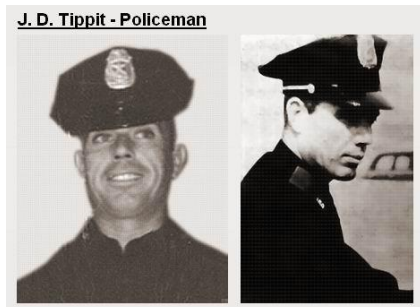
The suspect was officially taken into custody at the Texas Theater at 1:51 p.m. and brought into police headquarters at about 2 p.m. Oswald was soon after ushered into Captain Will Fritz’s office for the first of several interrogations by Fritz and other law enforcement officials. Then, sometime after 4 p.m., suspect Oswald was brought down to the basement assembly room for his first lineup. It was at this time that Dallas officers supposedly searched Oswald and, surprise, surprise, found five additional Western-Winchester .38 Special live rounds in his trousers pocket.
Not long ago I reached out to Frank Griffin, author of the book Touched by Fire. Griffin was a young man in 1963 who, from his vantage point at 10th & Denver, heard the shots nearly a block away that took Officer Tippit’s life. Griffin stepped quickly onto the sidewalk, glanced to the west, and spotted Tippit’s killer walking away from the patrol car and escaping south on Patton Avenue. Griffin maintains that he was able to identify Oswald as the shooter even though he was at least 300 feet away and Griffin never saw the killer from the front. “I had exceptional vision,” Griffin explained, and was a crack shot in the military. Well, at that same age, I was a fit, competitive runner who had completed the open mile at the Junior Olympics in just over 4 minutes and 20 seconds. Had I finished the mile in just over 2 minutes and 20 seconds, I would have not been human — I would have been a horse. And if Frank Griffin or anyone else can make a positive identification on a stranger at 300 feet or farther, they aren’t human either — they must be an eagle.
Was Frank Griffin not telling the truth? No, not really. Not at all, in fact. That is how the human mind works. Our memory is not like some videotape that can be endlessly played back, over and over, such as the Zapruder film. Instead, our minds tend to edit and distort memories over time. Mr. Griffin’s mind, and other folks’ minds, have taken the repeated image of Lee Oswald and, over the months and years, superimposed it on the memory of the figure they saw for but a moment the day JFK and Officer Tippit were killed. It is called by some the power of suggestion, and it is a force that is wholly underestimated by most.
I did ask Frank one more important question. While too far to have positively ID’d Tippit’s killer, Mr. Griffin was still standing in a direct line of sight (and sound) from the incident. So, I asked Griffin how many pistol shots he had heard.
“Four,” was the witness’s reply. “I clearly heard four shots.”
And if Franklin (Frank) Griffin is correct, and he heard four and only four pistol shots on E 10th Street that day, then Lee Oswald is very clearly innocent of the murder of Officer J.D. Tippit.


